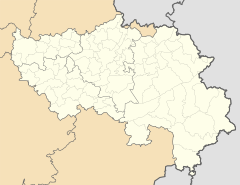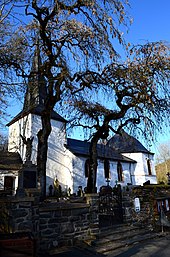Ouren (Burg-Reuland)
| Ouren | ||
|---|---|---|

|

|
|
|
|
||
| State : |
|
|
| Region : | Wallonia | |
| Province : | Liege | |
| District : | Verviers | |
| Coordinates : | 50 ° 8 ′ N , 6 ° 8 ′ E | |
| Residents: | 129 pop. | |
| Website: | www.reuland-ouren.be/home/ | |
Ouren is a village in the Belgian Eifel with 129 inhabitants, which belongs to the municipality of Burg-Reuland in the German-speaking Community . In summer Ouren is the destination of numerous tourists who, for example, populate the local campsite, as well as youth groups who spend their summer camp here.
geography
Ouren is located in the Ourtal at the border triangle Belgium - Germany - Luxembourg . The three borders meet here in the middle of the Our.
The place has two spatially separated town centers on both sides of the Our: on the one hand the district Peterskirchen, which originally emerged as an independent village community around the Peterskirche on the right side of the river, on the other hand the district Ouren around the castle hill of the former castle Ouren on the left side of the river, the arose from the freedom of the aristocratic residence.
Due to its location in the narrow river valley of the Our, the place is not accessed by main roads, but by a north-south running road from Luxembourg to Reuland .
history
The area of Ouren was already settled in Roman times, as evidence of an ancient hypocausted building remains . From at least the 11th or 12th century there was a castle in Ouren on the left bank of the Our, with which the history of the village is closely connected. The family of the Lords of Ouren is mentioned for the first time in 1095 with Rycardis de Hunrin. It can be assumed that Ouren Castle already existed at that time. In 1365 the castle came into the possession of the Malberg family through the marriage of Wilhelm von Malberg to Elisabeth von Ouren . Shortly afterwards, Ouren Castle was pledged to the Archbishop of Trier . During a feud between Archbishop Werner von Falkenstein and Eberhard von der Marck-Arenberg , the fortification was besieged and taken by episcopal soldiers under Peter von Kronenburg .
After the end of the Spanish War of Succession , the rule of Ouren became part of the Austrian Netherlands from 1714 to 1795 . In 1795, Ouren Castle was destroyed by French revolutionary troops. During the clapper war , insurgents holed up in the ruins of the castle, but after a short battle had to surrender to the French.
In 1815 Ouren was added to the Kingdom of Prussia at the Congress of Vienna, together with Eupen and Malmedy . In 1844 and 1845, the now uninhabited castle was auctioned twice and ultimately abandoned for demolition. Nowadays only a few remains of the castle wall are preserved.
As a result of the First World War , Ouren was awarded to Belgium under the Treaty of Versailles .
Attractions
European monument
If you leave the town center in the direction of Lieler in Luxembourg , you will soon reach the confluence of the Ribbach and Our rivers . The European monument, inaugurated on October 22, 1977, stands there . It goes back to an initiative by Georges Wagner, who in 1967 as President of the Association of the Eifel and Ardennes as well as Member and President of the Chamber in Luxembourg suggested the erection of the monument. The European monument is surrounded by a green area with five large stone blocks, information boards and flagpoles. The names of the “champions for a united Europe” ( Konrad Adenauer , Joseph Bech , Paul-Henri Spaak and Robert Schuman ) are attached to four stones . The memorial stones come from the respective countries of origin of the named founding fathers. A gneiss boulder from the Lüneburg Heath for Adenauer, a sandstone block from the Mullerthal- Waldbillig for Bech, a blue slate from the High Fens for Spaak and a slate block from the Vogessen for Schuman. The fifth stone commemorates the Treaty of Rome and the signatories from the six participating states. Not far from the European monument and directly at the actual three-country point, a pedestrian bridge connecting Germany and Belgium leads over the Our, which was named after Georg Wagner.
Peterskirche
Main article St. Peter and Paul (Ouren)
The Catholic parish church of St. Peter and Paul is a Gothic building that also contains Romanesque style elements. It forms the core of the Peterskirchen district and was in the 12./13. Built in the 18th century as a private church of the Lords of Ouren. It is under the patronage of Peter and Paul .
The structure consists of plastered quarry stone masonry. In a linear arrangement, from west to east, the entrance hall, bell tower, a single-nave nave and an octagonal choir with a sacristy in the north-east follow . The slate-covered west tower and the nave go back to a Romanesque building. In the 15./16. In the 18th century, it was rebuilt in the Eifel Gothic style . In 1741 the octagonal choir was renewed and the entrance hall was added. The sacristy was built in 1912.
The church itself and the Way of the Cross, which was laid out in 1896, are listed as historical monuments.
Knight jump
The Knight's Jump is a rock at the northern entrance to Ouren-Peterskirchen, from which, according to legend, a knight and his lover rushed into the Our on horseback to escape their pursuers.
According to legend, a robber baron was in love with the wife of the Lord of Ouren. He thought up a ruse to kidnap the noble lady. After a night meeting at the foot of Ouren Castle, he rode off with the lady. He had previously shod his horse, but had the irons attached the wrong way round. In this way he wanted to deceive the pursuers. The new irons made a lot of noise on the rocky ground so that the pursuers could hear the couple from a distance. They placed the fugitives on the rock that broke off steeply to the Our, which trapped the couple. In order to escape captivity, the robber baron urged his horse on, which with both riders jumped from the rock in high leaps. The lovers fell into the waters of the Our, but survived. Only the horse broke its legs. As a thank you for the miraculous rescue, the robber baron vowed to donate a chapel on the rock. However, he did not fulfill this vow and was struck by lightning.
Ouren castle ruins
Main article Ouren Castle
The castle ruins are located on a spur in the town center on the left side of the river. Ouren Castle was the ancestral seat of the noble family of the Lords of Ouren . The complex, which dates back to the 11th century, was originally a castle fortress with a palas , a keep and a castle chapel as well as a bailey . During the renovation phases in 1535 and 1615, the change from a castle to a palace with living comfort was completed. A surviving drawing of a lost watercolor by Joseph-Ernest Buschmann (1814–1853) from the mid-19th century shows the complex as a - presumably romanticized - baroque palace. In 1794 the castle was destroyed by French revolutionary troops and almost completely demolished after 1845.
The castle ruins are now a ground monument . Only individual remains of the foundation and parts of the former surrounding wall are visible. The Archaeological Service of the German-speaking Community of Belgium (DG) has been carrying out excavations on the castle hill since 2012 .
Personalities
- Joseph Belling OSB (* 1939), painter, sculptor and graphic artist
- Roger Greisch (1917–1999), teacher and painter, lived in Ouren from 1947 until his death
Awards
- 2001: Silver medal at the European flower competition Entente Florale Europe in the category "Villages"
literature
- Karl Leopold Kaufmann : The Malmedy Border District 1815–1865. Röhrscheid, Bonn 1963.
- Heribert Reiners : with the collaboration of Heinrich Neu : Die Kunstdenkmäler von Eupen – Malmedy. L. Schwann Verlag, Düsseldorf 1935 (reprint of Pädagogischer Verlag Schwann, Düsseldorf 1982, ISBN 3-590-32117-2 ), pp. 386-391.
- Bernhard Willems: The Lordship of Ouren. In: Between the Venn and the Schneifel. Volume 1, 1965, pp. 6-7.
Web links
- Klaus-Dieter Klauser: ZVS circular hike through Ouren. o. O., 2011. (Accessed November 6, 2014).
Individual evidence
- ^ Population statistics
- ↑ Quirin Esser: Roman traces near Ouren. Circular sheet for the Malmedy district. 1882. No. 32.
- ↑ a b Information on the village of Ouren
- ↑ Article on Ouren Castle in the daily GrenzEcho
- ↑ European monument in the Ourtal ( Memento from September 9, 2012 in the web archive archive.today )
- ↑ The Peters Church in Ouren
- ↑ Ouren - Sights ( Memento of the original of September 24, 2015 in the Internet Archive ) Info: The archive link was automatically inserted and not yet checked. Please check the original and archive link according to the instructions and then remove this notice.
- ↑ a b ZVS information on Ouren
- ↑ The legend of knight jumping on reuland-ouren.be.
- ↑ Drawing of the watercolor after Buschmann approx. 1840-1850.
- ↑ Information on Ourener artists
- ↑ Ouren flower village on burg-reuland.be.






